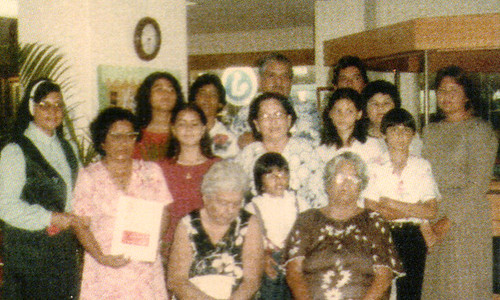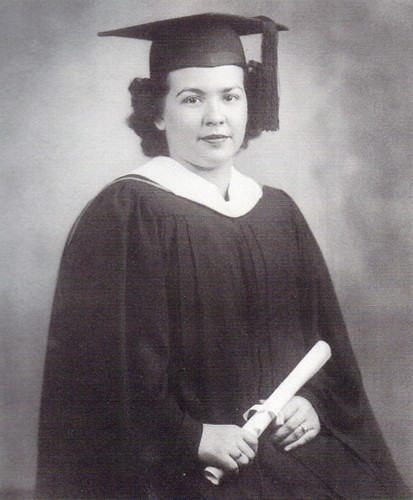View more photos for the Rosa Perez Salas entry here.
Educator and advocate
Rosa Teresita Perez Salas (1926-1998) was an educator and vocal advocate for the physically and intellectually disabled, as well as the elderly. Salas earned her reputation as an accomplished leader and for improving Guam’s educational system, particularly as it affected children with disabilities.
Salas, nicknamed “Beta,” was born on 8 October 1926 to Remedios LG and Juan Diaz Perez of Hagåtña. She grew up during the United States Naval Era (1898-1941) before World War II as a typical Chamorro girl, chaperoned, and protected. She wanted to become a teacher like her mother, who was a noted educator. Although there was some initial resistance from her family regarding her plans to travel abroad to study after high school, Salas’ uncle, former Senator Pete Perez, Sr., along with her aunt and music teacher, former Senator Lagrimas LG Untalan, spoke strongly on her behalf and influenced her parents to allow her to go.
After graduating as Salutatorian in 1946 at George Washington High School, Salas began her career as an elementary school teacher just prior to furthering her education off-island. Salas first studied at La Escuela, Inter Americana de Verano in Satillo, Mexico. With a government honor tuition scholarship (1947-1950), she then enrolled at the College of Saint Catherine at Saint Paul, Minnesota, where she earned a Bachelor’s degree in English with a minor in elementary education in 1950.
Homesickness was almost unbearable for Salas but she eventually returned home to her family in Guam. Shortly afterward she married G. Ricardo “Ric” Salas following years of a long distance courtship while both were attending college. They were married on 26 November 1951 in a ceremony officiated by Father Cyril Langheim, OFM, Cap., at the Dulce Nombre de Maria Cathedral in Hagåtña.
Salas taught English and music classes for five years at George Washington High School, spent three years as an instructor at the College of Guam, and then became assistant principal at Sinajana Elementary School for two years where she developed an interest in special education. She wondered how the educational system could help a child from having to spend years in the same grade or what to do with a hyperactive child. These questions challenged Salas to get special training to provide answers.
Once again, Salas went abroad, this time with a government scholarship to attend Los Angeles State University (now UCLA) where she received her master’s degree in Special Education in 1962. Returning to Guam, her career took off as she moved from teacher into administrative duties as acting Superintendent of Schools (1962-1963); first Headstart Director (1963-1964); Associate Superintendent of Curriculum and Instruction (1964-1966); and Associate Superintendent of Elementary and Special Education (1966-1969), which was the post her mother vacated when she retired in 1957. This last position involved the supervision of 22 elementary school principals and 20,000 elementary school children.
Following her mother’s colorful 49-year service in education, Salas went a step further when she was appointed Chief of the Division of Vocational Rehabilitation in 1969 by Governor Carlos G. Camacho. During this period, Salas started the School for the Deaf at New Piti School in 1969 as the first locally-funded program for the intellectually disabled and the deaf. Before this local funding was found, teachers would voluntarily take extra students so that children with special needs could be taught separately. Salas was ecstatic when the Elementary Secondary Education Act, Title I, provided federal funding for bilingual and culturally different children.
In a Pacific Daily News interview, Salas explained her excitement:
What was often thought of as mental retardation was actually cultural deprivation and language handicaps. The goal of Vocational Rehabilitation is to channel handicapped persons into work-a-day world. And this we shall do. The first step is evaluation – medical and psychological.
Seven years later, Salas lobbied to make the division a separate Government of Guam department. She was met with success and became the first director of the Department of Vocational Rehabilitation (1976-1979), as appointed by Governor Ricardo J. Bordallo.
With the election of a new administration in 1979, however, she was asked to resign, but her achievements did not go unrecognized. In Resolution No. 261 authored by Senator Francisco R. Santos of Sinajana, the Fifteenth Guam Legislature commended Salas for her outstanding service to the people of Guam and service to the Educational and Vocational Systems.
This temporary retirement also did not slow Salas down. She kept active in the family business, the Salas Agency, and took her grandchild, Richard Conrad, Jr., on a round-the-world tour. She served as president of the Soroptomist of Hagåtña, an international organization of business and executive women, and was a member of the Hagåtña Municipal Planning Council and the Advisory Council for the College of Agriculture and Life Sciences at the University of Guam.
Salas was a devout Catholic and long served the Dulce Nombre de Maria Cathedral-Basilica in Hagåtña as an organist for 32 years, since 1950 until 1982. In 1974, she was awarded the most elite women’s honor in the Catholic Church, the Pro Ecclesia et Pontifice Award by Pope Paul VI.
In 1984, Governor Ricardo J. Bordallo re-appointed the veteran administrator as director of Department of Vocational Rehabilitation, a post she held until 1990.
On 21 June 1990 Governor Joseph F. Ada issued Proclamation No. 90-75 proclaiming 30 June 1990, as “Rosa T. P. Salas Day” for her outstanding public service, as she retired due to health reasons. “Such service is vital in the rehabilitation of the physically and/or developmentally disabled, to enable these persons to lead happy, productive, and useful lives within the community of Guam” stated the Proclamation.
Salas believed she did her best to help people understand that handicapped people can earn a living and do not have to be a burden on their families or the government, and made efforts to help the disabled find viable employment. However, she faced obstacles to her goals of getting jobs for the handicapped, such as exorbitant costs, lack of trained personnel and the problems of wheelchair accessibility during her tenure as director. Nevertheless, she derived great satisfaction in creating rehabilitation programs, and found the opportunity to serve the people very rewarding: “That’s really the whole thing – loving and helping your neighbor, especially those who are less fortunate than me.” Salas indicated that the highlight of her tenure was raising vocational rehabilitation from a division within the Department of Education to its present status as a separate department.
Salas contributed to several journals of education and spoke at various conferences locally and nationally on the topics of mental retardation and occupations for the elderly. She was an active member in numerous community and religious organizations, with a particular focus on the Lytico and Bodig Association and the Marianas Association for Retarded Children.
She died on 15 July 1998.
For further reading
Grace, H. Ted. “Education in Guam Marches On.” Peabody Journal of Education 44, no. 1 (July 1966): 37-39.
Salas, Rosa Perez. “Vocational and Social Aspects for the Mentally Retarded on Guam.” Report presented at the Second Asian Conference on Mental Retardation – Japan League for the Mentally Retarded, Tokyo, Japan, 1975.
–––. “Guam Department of Vocational Rehabilitation.” Educational Perspective 15, no. 4 (December 1976).
“Rosa Perez Salas.” In I Manfåyi: Who’s Who in Chamorro History. Vol. 2. The Hale’-ta Series. Hagåtña: Political Status Education and Coordinating Commission, 1997.



